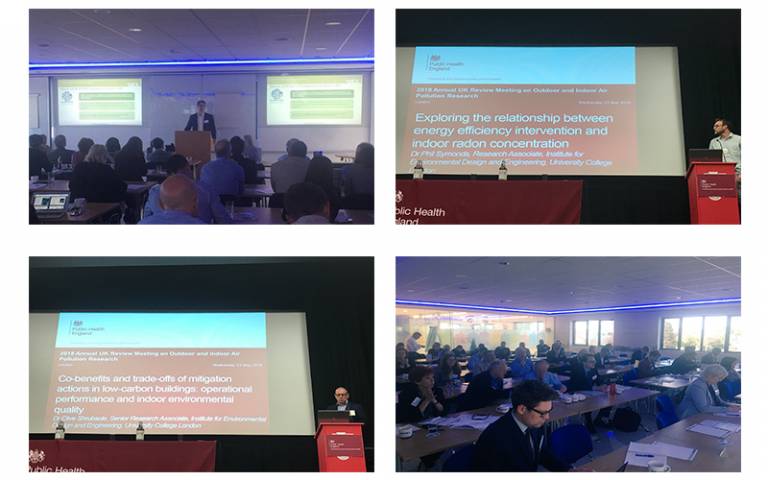Two weeks, two conferences, one Focus
11 June 2018
UCL IEDE staff participate at UKIEG and PHE conferences.

It started on the 17th May with the UK Indoor Environments Group (UKIEG) Conferences hosted by BEEMA in High Wycombe and focusing on Ventilation, Indoor Air Quality and Human Health. It represents a one-day networking event for a multidisciplinary audience of academics, policy makers and industry experts with an interest in improving indoor environments for health and wellbeing.
The first session chaired by UCL IEDE’s Dr Marcella Ucci saw the keynote address given by Professor Stephen Holgate CBE on ‘Indoor air pollution: An under recognised public health’ challenge to a packed and engaged audience. UCL was further represented by Dr Evangelia Chrysikou speaking on Indoor and outdoor air quality in closed psychiatric wards; IEDE’s Dr Clive Shrubsole presenting outputs from the TOP project in ‘Towards optimising building control strategies for energy, health and well-being’ and finally IEDE MEng researcher Dzhordzhio Naldzhiev, sharing research on ‘Spray foam insulation, VOCs and indoor air quality – discovering the known unknowns’. Delegates agreed both the management, facilities and refreshments were excellent as well as noting the wide range of in-depth and quality research currently being carried out on the indoor environment, of which UCL was well represented.
The following week Public Health England (PHE), a government agency held their ‘Annual UK Review Meeting on Outdoor and Indoor Air Pollution Research in London on Wednesday 23rd May. The location was the cinema complex within the Imperial War Museum. Again, the room was packed attesting to the rise in the profile of the important topic of air pollution and health. The meeting was opened by Professor Paul Cosford, Director for Health Protection and Medical Director, PHE. Again UCL IEDE was present with talks by Dr Clive Shrubsole on ‘co-benefits and trade-offs of mitigation actions in low-carbon buildings: operational performance and indoor environmental quality’ and Dr Phil Symonds ‘exploring the relationship between energy efficiency interventions and indoor radon concentrations’.
The presence of two prestigious conferences on the subjects of indoor air quality and health in such close proximity, shows the importance of the subject matter and its rising profile, once again confirming the need for the new MSc on Health and Wellbeing in Sustainable Buildings.
 Close
Close

